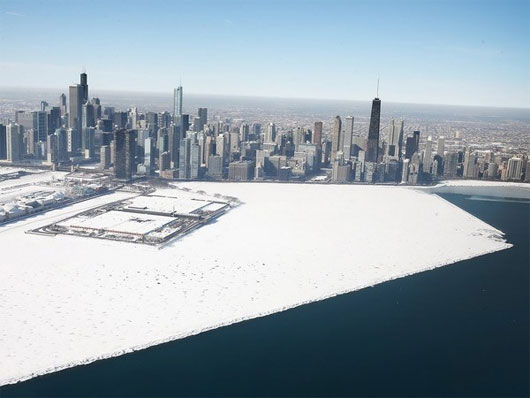Central and Eastern North America are submerged in snow
A very fast blizzard has hit the Central and Northeastern United States from the night of March 2 and continues throughout March 3, making Washington and many states in the affected area sunk. flooded with frost and rain.
>>>The area of the US capital of Washington sinks in ice
According to a report from the National Weather Service (NWS), with an average of 25-35cm of snow, the new blizzard crippled the operation of a large area extending from the Mississippi Valley of the state. Mississippi is at the southern end of South and North Carolina to the Washington metropolitan area and many states in the Central.
Heavy snowfall and a drop in the average temperature of -10 to -12 degrees Celsius have caused rivers to freeze and traffic to be paralyzed. Particularly in the night of March 2 and March 3, about 2,900 flights were canceled and about 5,000 other flights were delayed because of the storm.
Heavy snow rain also turned highways and streets in cities into glaciers, causing traffic vehicles to be trapped for hours by car's death. Meanwhile, there have been five traffic-related deaths in bad weather reported in Virginia, Texas, Oklahoma and Tennessee states.

The white snow cover along Lake Michigan in Chicago, Illinois, USA.(Source: AFP / VNA)
The storm forced authorities to order the offices of the federal government in Washington to be closed, allowing hundreds of thousands of civil servants to quit.
The US Congress also postponed discussion plans and voting because of bad weather.
New Jersey and Delaware, Mississippi and Tennessee governors had to declare a state of emergency, while schools and local government offices were also ordered to close. Residents in affected areas are also advised not to go out in bad weather.
This is the latest snowstorm in a series of blizzards that have landed in the United States this winter, a winter that is considered unprecedented harsh in history.
Blizzards plus a record cold in early January significantly slowed down the recovery trend of the world's largest economy.
On February 14, the Federal Reserve Bank (FED) said the output of its factories and factories in the first month of the year suddenly dropped by 0.8%, compared with an increase of 0.3. % in December 2013. This is the record reduction since September 2009 and is the first reduction since July 2013.
On February 28, the US Department of Commerce also lowered its growth forecast for the US economy in the last quarter of 2013 due to a variety of reasons, including the harsh winter.
According to the ministry's forecast, the country's GDP growth rate in Q4 / 2013 is likely to reach only 2.4%, much lower than the expected 3.2%. in the previous month. GDP growth rate in the first quarter of this year is also expected to be significantly affected by abnormal extreme weather.
- America: at least 20 people die from the cold
- Cold air continues to affect the North Central
- America: The central region is submerged in a snowstorm
- Drought lasts for centuries in North America
- USA: Anchorage city snowed 3.4m
- Hot sun returns to the North and Central
- Cold air intensified to the North
- Tsunami awaits to attack the coastal areas of Vietnam
- The temperature in the Northern provinces continues to decline
- Cold air poured down North Central
- Why is Hanoi and North and Central hot and hot?
- Central America suffered from many natural disasters
 Is the magnetic North Pole shift dangerous to humanity?
Is the magnetic North Pole shift dangerous to humanity? Washington legalizes the recycling of human bodies into fertilizer
Washington legalizes the recycling of human bodies into fertilizer Lightning stone - the mysterious guest
Lightning stone - the mysterious guest Stunned by the mysterious sunset, strange appearance
Stunned by the mysterious sunset, strange appearance